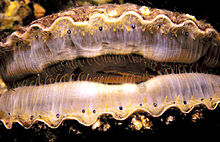
Coastwise member and keen diver Chris Mandry shared his love of scallops with other members in a fascinating talk. Chris outlined the anatomy and works of the bivalve. Members learned that the hermaphrodite reproduces by releaseing large amounts of roe and sperm in ealy spring, but mainly in autumn, although the resulting plankton are not often seen in shore-based samples of seawater. Its main predators are the starfish Astropeden irregularis and Asterias rubens, and as well as having a series of light-sensitive eyes, the scallop has chemical-sensitive tentacles to allow it to “clam up” and try and resist opening.
As a diver, Chris and his colleagues in Ilfracombe Sub-Aqua Club search for a take scallops on a completely sustainable basis, but he outlined how the commercial sector works, with destructive seafloor-raking net arrays. It is a not insignificant business with a national landed value of nearly £70m in 2012, and over 100 North Devon jobs dependant upon it.
To round off an interesting summary of an animal that non-diving Coastwise members generally see only as pieces of shell on the beach, Chris illustrated the extensive cultural and artistic use that the scallop has inspired.

